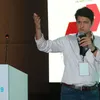‘Success is all about creating delightful experiences for the audience’ – design tips from Rufus Deuchler, Adobe Systems
This expert interview sheds some light on the growing contribution of design to business and technology communities. Design can make a product and message stand out and deliver a delightful user experience, says Rufus Deuchler.
Rufus Deuchler is Principal Manager of Creative Cloud Evangelism at Adobe Systems. He brings more than 25 years of hands-on experience using Adobe software to the creative table. Based in Italy, Rufus is responsible for the German version of Adobe Live, and is active in the European Creative Community.

Rufus is also a speaker at the upcoming DesignUp 2019 conference in Bengaluru, for which YourStory is the media partner. See our earlier coverage of DesignUp 2018 and 2017, and our d.Zen (‘Design Zen’) section for more resources on design.
Rufus joins us in this interview on the importance of clarity in design, global platforms for creative communities, and the power of audience delight.
Edited excerpts:
YourStory: In a world of information overload and unending distractions, what do you see as the key role of designers?
Rufus Deuchler: The key role of any design is to make a message stand out. Be that graphic design, product design, or experience design, anything that is designed is the result of an attempt to create something that will retain the audience’s attention and convey a message. So, I would say that the role of designers hasn’t changed over time.
It is the technologies, the delivery support, and the audience itself that have changed a lot, and designers must adapt to this rapid change swiftly. The core competency is to fully understand the fundamental need in order to deliver the right message. As you mention “in a world of information overload and unending distractions,” only clarity will emerge. If the audience doesn’t get your message right away, they have already moved on.
YS: How are platforms like cloud infrastructure democratising the field of design?
RD: Sharing platforms like Behance, Instagram, and so on, enable creatives all over the world to emerge with more ease. If there is talent, originality and passion, it will emerge. I bring the example of a young conceptual artist in Egypt who was discovered on Behance by a design agency in the UK, and who was then commissioned to create the album art for a Pink Floyd album.
This would have been very difficult, if not impossible, without an online infrastructure to share the work. But I always feel like I have to repeat this: success is never immediate; it takes a lot of work and passion.
YS: As the offline and online worlds converge, how can designers prepare better seamless experiences for consumers?
RD: It always comes back to my main point here: clarity of message. Only experiences that are seamless and crystal clear will delight the audience; others will fail. The deep understanding of what exactly it is that the design is trying to solve is so important. Also, user testing is equally important, and online systems allow for that on a large scale.

YS: What design lessons do you think ‘emerging economies’ like India can share with the rest of the world?
RD: The inspiration that comes from a millenary culture provides an incredible pool of regional and historical design elements that can be reimagined or built upon. India has such a marvellous history of art, crafts and design, and these can be used as building blocks to maintain that cultural heritage.
I am all for regional design; the world is varied and I strongly believe it should remain so. Uniformity is not very creative, is it? Traveling the world extensively, and meeting creatives from many different countries, I have come to the conclusion that creatives, independently of their country, all face the same challenges, but have their very own ways of responding to those challenges.
YS: How should techie founders deepen their understanding of design so as to offer better products/services?
RD: Success is all about creating delightful experiences for the audience. The first step is always to fully research and understand the audience, their aspirations, their pain points, what it is that they “really” need. The same way, designers need to fully understand their clients before attempting to solve any problem through design.
If the groundwork is solid, and the research thorough, the design process becomes a natural answer to the challenges exposed. As with any industry that relies on cooperation (you mention designers and developers), conversation and the sharing of information are really important. Each team must know what the other team is doing, and why and how. Working in silos is a recipe for failure.
YS: Which are your other favourite design festivals around the world, and what makes them special?
RD: I might be biased here, but the largest creativity conference is Adobe MAX, with our vision keynotes, luminaries on stage, and hundreds of sessions and workshops. It is such an inspiring event that gathers over 15,000 creators from over 65 countries in one place.
Another favourite is 99u in New York, and the OFFF Festival in Barcelona. And, of course, my new favourite one is DesignUp!
YS: What are three books designers must have on their bookshelf?
RD: Three books that I always refer to are:
Stop Stealing Sheep & Find Out How Type Works by Erik Spiekermann and E.M Ginger. The book explains how you can use type to enhance the legibility, meaning, and aesthetic level of your work.
Information Architects by Richard Saul Wurman. This book, published over 20 years ago, shows how the presentation of information can make complex material clear and accessible. And this is still so relevant today.
Grid Systems in Graphic Design by Josef Müller-Brockmann. As you can tell, I am obsessed by organising information, and grid systems are the cornerstone of a clean design.
YS: As we come to the close of 2019, what are three key emerging design trends you see in 2020?
RD: As I mentioned, for me clarity is paramount. In a world that is becoming increasingly complicated with mixed messages and blurred information, we as designers have a responsibility to provide crystal clear meaning that leaves no innuendo or misunderstanding in the audience’s mind.
Ironically, to emerge from a sea of noise, I have a feeling that in 2020 we need to go back to simplicity, and that involves (a) clear and legible typography, (b) muted colour palettes to contrast with the vivid ones that are now mainstream, and (c) minimalism. I think the old adage of “less is more” is becoming trendy again.









